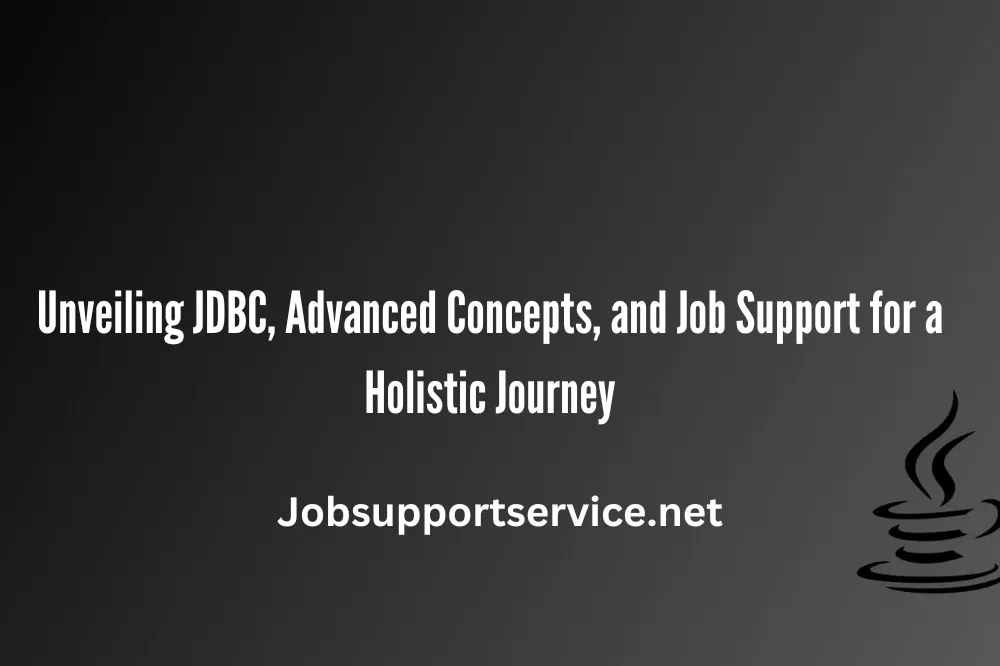Introduction:
Java, a stalwart in modern development, has played a pivotal role in shaping the software landscape. Its versatility, platform independence, and robustness have made it a go-to language for a myriad of applications. In this blog, we embark on a journey through three essential pillars of Java development: JDBC (Java Database Connectivity), Advanced Java Concepts, and Job Support.
JDBC (Java Database Connectivity): Unlocking the Power of Database Interaction:
Foundations of JDBC:
Java Database Connectivity (JDBC) serves as the bridge connecting Java applications with databases, forming a fundamental component of data interaction. At its core are essential components: Connection, establishing a link to the database; Statement, executing SQL queries; and ResultSet, handling the query results.
Performing CRUD Operations:
Executing Create, Read, Update, and Delete (CRUD) operations efficiently is imperative for any application interacting with databases. Techniques for seamless execution of these operations using JDBC are explored, along with best practices to ensure optimal data manipulation and retrieval.
Handling Transactions and Batch Processing:
Ensuring data consistency and integrity is achieved through effective transaction management in JDBC. This section delves into the principles of handling transactions and utilizing batch processing to optimize interactions with the database, particularly crucial in high-traffic applications.
Connection Pooling and Performance Optimization:
To enhance application performance, implementing connection pooling is essential. This section provides insights into connection pooling techniques and strategies for optimizing JDBC performance, particularly in scenarios with high traffic and resource demand.
Advanced Java Concepts: Elevating Your Java Development Skills:
Multithreading and Concurrency:
Multithreading is a cornerstone of Java development, allowing for parallel execution. Understanding thread lifecycles, synchronization, and leveraging Java’s concurrent utilities is essential for efficient multithreading and concurrent programming.
Exception Handling and Best Practices:
Exception handling is a critical aspect of writing robust and error-resilient code. Mastering exception handling techniques, adhering to best practices, and creating custom exceptions are explored to enhance error management and application stability.
Reflection and Annotations:
Dynamic class loading and introspection using reflection open doors to dynamic code execution. Annotations, on the other hand, offer a powerful way to enhance code functionality. This section provides an in-depth exploration of both concepts and their practical applications.
Java Messaging Service (JMS) and Message-Driven Beans:
Java Messaging Service (JMS) facilitates asynchronous communication, a crucial aspect of modern applications. Implementing Message-Driven Beans in Java EE applications enhances the scalability and responsiveness of enterprise-level systems.
Bridging the Gap Between Learning and Application:
This section transitions from theoretical knowledge to real-world application, focusing on Full Stack Development in Java. It provides an overview of key technologies and frameworks in the Java Full Stack ecosystem, including Spring and Hibernate.
Interview Preparation Tips and Common Technical Questions:
Guidance on preparing for technical interviews specific to Full Stack Development is essential for job seekers. This section offers tips, insights, and effective strategies for answering commonly asked technical questions.
On-the-Job Challenges and Solutions:
Real-world projects present unique challenges. Identifying common challenges faced by Java Full Stack developers and providing practical solutions and strategies to overcome these obstacles is crucial for success in a professional setting.
Continuous Learning in the Dynamic Full Stack Environment:
Emphasizing the importance of continuous learning in the ever-evolving Full Stack development landscape, this section offers resources and strategies to stay updated on the latest trends and technologies. Continuous learning is not only a professional necessity but a mindset that fosters adaptability and innovation.
Conclusion:
In wrapping up our journey through JDBC, Advanced Java full stack Job Support, we’ve covered the foundational elements, elevated coding practices, and bridged the gap between theoretical knowledge and real-world application. It’s now incumbent upon developers to integrate these skills into their Java toolkit, embracing a holistic approach that combines practical knowledge, advanced concepts, and a commitment to continuous learning. As the Java development landscape evolves, this multifaceted skill set ensures a successful and fulfilling career.
- Machine Learning Operations on GCP: Job Support Essentials - May 20, 2024
- Serverless Computing Support on GCP: Expert Advice - May 18, 2024
- Database Administration in GCP: Job Support Best Practices - May 17, 2024

